PCB Remediation Technologies: Innovative Cleanup Solutions
- Last Updated: June 12th, 2025

Attorney Jessie Paluch, founder of TruLaw, has over 25 years of experience as a personal injury and mass tort attorney, and previously worked as an international tax attorney at Deloitte. Jessie collaborates with attorneys nationwide — enabling her to share reliable, up-to-date legal information with our readers.
Legally Reviewed
This article has been written and reviewed for legal accuracy and clarity by the team of writers and legal experts at TruLawsuit Info and is as accurate as possible. This content should not be taken as legal advice from an attorney. If you would like to learn more about our owner and experienced injury lawyer, Jessie Paluch, you can do so here.
Fact-Checked
TruLawsuit Info does everything possible to make sure the information in this article is up to date and accurate. If you need specific legal advice about your case, contact our team by using the chat on the bottom of this page. This article should not be taken as advice from an attorney.
Key Takeaways:
- Due to their bioaccumulation and resistance to natural degradation processes, PCBs are persistent organic pollutants that pose significant environmental and health risks.
- PCB contamination primarily results from improper handling, disposal, and manufacturing practices, such as inadequate containment measures and accidental spills.
- Effective management of PCB-contaminated sites requires comprehensive site investigation techniques, risk-based approaches to prioritize cleanup efforts, stakeholder engagement, and innovative remediation technologies.
Overview of PCB Remediation
On this page, we’ll discuss the process of PCB Remediation, techniques used to clean up PCB-contaminated sites, the importance of PCB remediation in protecting human health and the environment, and much more.
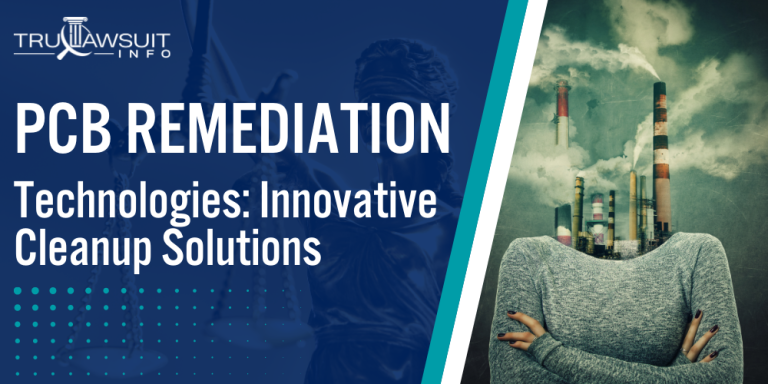
Intro to PCB Remediation
Some of the key aspects of PCB remediation include, but are not limited to:
- Site Assessment: A thorough assessment of the contaminated site is conducted to determine the extent and nature of PCB contamination.
- Remediation Techniques: Various remediation methods, such as excavation, dredging, and in-situ treatment are established based on site-specific conditions and the level of contamination.
- Regulatory Compliance: PCB remediation must adhere to strict regulatory standards set by the EPA and other relevant agencies to protect human health and the environment.
- Long-term Monitoring: Post-remediation monitoring is essential to ensure the effectiveness of the cleanup efforts and to detect any potential recontamination.
Suppose you are responsible for a PCB-contaminated site or have been impacted by PCB contamination.
Contact TruLawsuit Info today using the chat on this page to learn more about PCB remediation and how it can help address the harmful effects of PCB contamination.
Table of Contents
Overview of PCB Remediation
On this page, we’ll discuss an overview of PCB remediation, methods to address polychlorinated biphenyls (PCBs), regulations by the Environmental Protection Agency (EPA), handling of PCB-contaminated sediments, and best practices for dealing with PCB-contaminated soils.
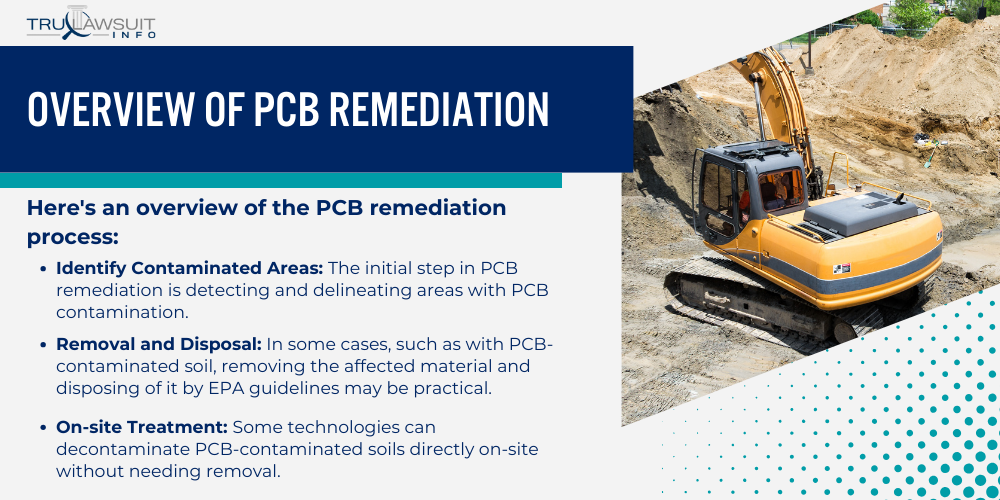
Intro to PCB Remediation
PCBs, or polychlorinated biphenyls, are a group of human-made chemicals banned in the US due to environmental and health risks.
Unfortunately, PCBs were widely used in building materials and equipment before the ban, and now require proper remediation if discovered.
Here’s an overview of the PCB remediation process:
- Identify Contaminated Areas: The initial step in PCB remediation is detecting and delineating areas with PCB contamination.
- Removal and Disposal: In some cases, such as with PCB-contaminated soil, removing the affected material and disposing of it by EPA guidelines may be practical.
- On-site Treatment: Some technologies can decontaminate PCB-contaminated soils directly on-site without needing removal.
- Stabilizing Contamination: In certain scenarios, especially where removing PCB-contaminated sediment is not viable, capping may stabilize the PCBs.
- Monitoring and Verification: After remediation, ongoing monitoring ensures that recontamination does not occur and that the remediation efforts remain effective.
Strict EPA regulations govern the remediation of areas impacted by PCBs.
Managing PCB remediation waste requires careful planning and execution to ensure compliance with laws and protect public health and the environment.
Advances in Physical PCB Remediation Treatment Methods
Physical PCB remediation methods are vital in mitigating the environmental impact of PCB-contaminated sites.
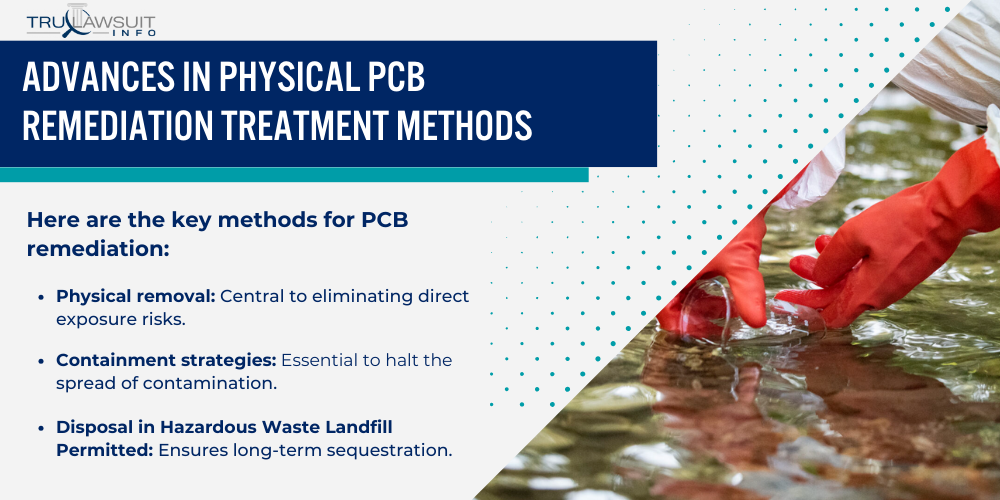
These advances aim to improve the efficiency and effectiveness of cleanup activities and ensure the responsible handling of hazardous waste.
Importance of Effective PCB Remediation for the Environment
Polychlorinated biphenyls (PCBs), once used widely in industrial applications, persist in the environment due to their chemical stability and are considered hazardous waste.
Effective remediation is essential to reduce the health risks associated with contaminated sites and prevent further environmental damage.
Here are the key methods for PCB remediation:
- Physical removal: Central to eliminating direct exposure risks.
- Containment strategies: Essential to halt the spread of contamination.
- Disposal in Hazardous Waste Landfill Permitted: Ensures long-term sequestration.
- Environmental compliance: Meets cleanup and disposal obligations imposed by regulatory frameworks.
New Developments in Excavation & Dredging Technologies
Innovations in excavation and dredging have led to more precise and less intrusive methods of dealing with bulk PCB remediation waste.
Excavation advancements include:
- Automation for increased safety and efficiency
- Enhanced sorting techniques to segregate PCB-contaminated material
- Improved transport logistics for moving contaminated soil to hazardous waste landfills
- Real-time monitoring systems for immediate quality control
Dredging Technology Innovations for PCBs
These advancements allow for targeted dredging, minimizing the amount of aquatic environment disturbed during PCB removal.
Additionally, improved sediment sifting separates PCBs from clean material, streamlining the decontamination process.
Innovations in dredging technology include, but are not limited to:
- Precise navigational systems to minimize disruptions in aquatic environments
- Sediment sifting developments that separate PCBs from clean material
- Decontamination protocols that treat water on-site
- Eco-friendly disposal methods ensuring clean-up site restoration
Innovations in Thermal Desorption for PCB Remediation
Thermal desorption has evolved to treat various contaminated material types, including soil and organic matrices.
Notable innovations include:
- High-temperature systems that break down PCB molecules effectively
- Low-temperature thermal desorption catering to sensitive site conditions
- Portable units allowing on-site treatment of contaminated soil
- Systems that harness treated material, such as using treated soil to form a concrete or asphalt cap
Each method neutralizes PCB toxicity, facilitating safe and compliant disposal or enabling material reutilization at the cleanup site.
Progress in Chemical PCB Remediation Solutions & Tools
Significant developments in chemical methods for PCB remediation have enhanced the capabilities for safe and effective cleanup of contaminated sites.
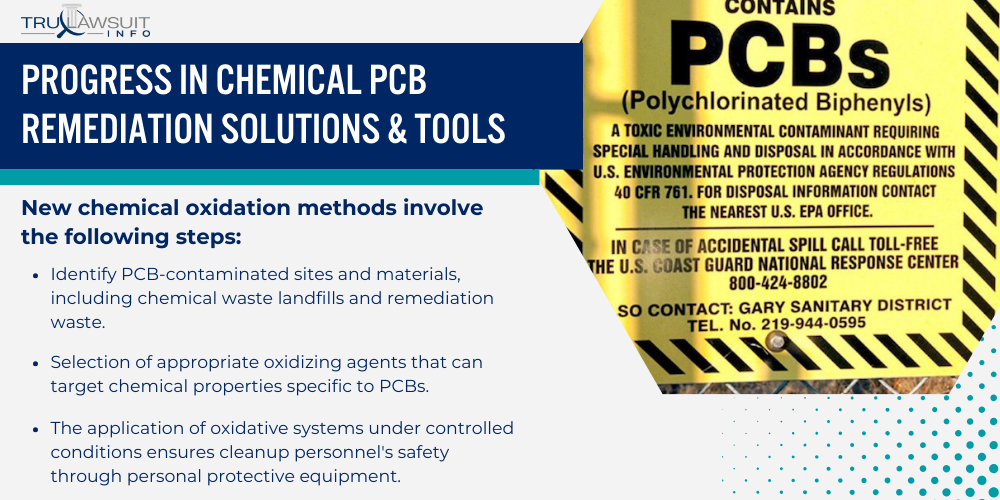
These advancements focus on improving the efficacy of degradation and ensuring the safety of the surrounding environment and individuals involved in the process.
Latest in Chemical Oxidation Methods for PCB Cleanup
Chemical oxidation has shown promise in breaking down PCB molecules into less harmful compounds.
New chemical oxidation methods involve the following steps:
- Identify PCB-contaminated sites and materials, including chemical waste landfills and remediation waste.
- Selection of appropriate oxidizing agents that can target chemical properties specific to PCBs.
- The application of oxidative systems under controlled conditions ensures cleanup personnel’s safety through personal protective equipment.
- Monitoring PCB degradation to evaluate the success of the oxidation method in actual cleanup scenarios.
Chemical oxidation stands out for its ability to tackle different classes of PCBs by altering their chemical structure, rendering them into non-toxic or less harmful substances.
Emerging Solvent Extraction Techniques for Remediation
Solvent extraction has become a more prevalent strategy for PCB decontamination.
The process involves:
- Use solvent solutions to dissolve PCBs from soils and sediments in cleanup wastes.
- Optimization of solvent types to enhance efficiency in PCB cleanup and disposal.
- Development of technologies aimed at recycling solvents post-extraction, reducing chemical waste landfills.
- Implementation of stringent waste handling protocols to prevent secondary contamination from remediation waste.
With strategic application, solvent extraction offers a viable path to minimize the volume of contaminated materials destined for chemical waste landfills.
Biological PCB Remediation Approaches Gaining Traction
Interest in biological methods for dealing with PCB contamination has increased due to their effectiveness and environmentally friendly nature.
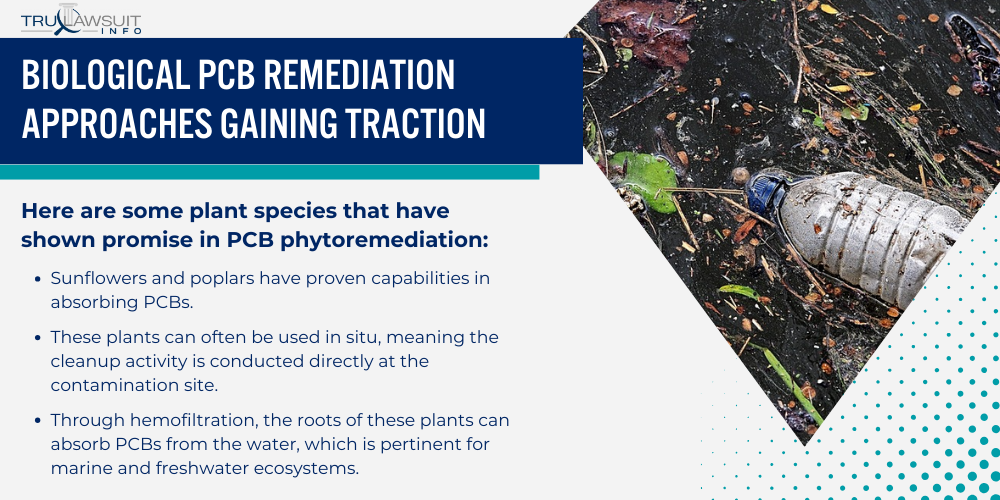
These methods utilize natural processes to degrade PCBs, offering the potential for risk-based cleanup at environmentally diverse sites.
Phytoremediation: Using Plants to Remediate PCB Sites
Phytoremediation harnesses the ability of certain plants to absorb, concentrate, and metabolize toxic substances from soil and water, making it a valuable tool in cleaning up PCBs.
Plants at PCB-contaminated sites may reduce the environment’s toxic burden and improve site characterization data by interacting with pollutants.
Here are some plant species that have shown promise in PCB phytoremediation:
- Sunflowers and poplars have proven capabilities in absorbing PCBs.
- These plants can often be used in situ, meaning the cleanup activity is conducted directly at the contamination site.
- Through hemofiltration, the roots of these plants can absorb PCBs from the water, which is pertinent for marine and freshwater ecosystems.
- Given the site’s specific conditions, the local environmental protection agency usually reviews the feasibility of this approach.
Potential of Microbial Degradation in PCB Remediation
Microorganisms, including specific bacterial and fungal strains, present promising avenues for PCB degradation.
Indigenous microbes at contaminated sites can often be stimulated or augmented to break down PCBs more effectively.
Microbial remediation offers several advantages for PCB cleanup:
- Bioremediation strategies often involve tailoring interventions to the existing microbial population at contaminated sites.
- In situ microbial treatment avoids the need for extensive, disruptive excavation.
- Coordination with local environmental protection agencies ensures compliance and monitoring through the self-implementing cleanup protocols.
- The effectiveness of microbial action depends on a thorough understanding of the existing site characterization data and the risk-based cleanup objectives.
Biological remediation methods are gaining validity as they complement current cleanup approaches and potentially reduce long-term costs and environmental impacts.
They promise to restore sites burdened by PCBs through processes that integrate seamlessly with natural ecosystems.
Combining PCB Remediation Technologies for Optimal Results
The effectiveness of PCB remediation often depends on the strategic combination of multiple technologies tailored to the site’s specific challenges.
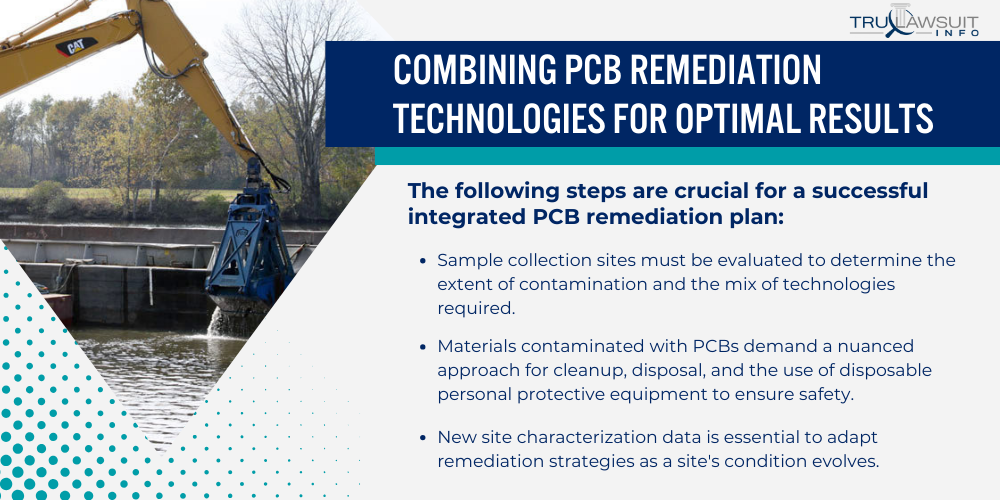
Integrated Strategies for Tackling Complex PCB Pollution
Key strategies for addressing PCB pollution involve using various methods to handle the ecological variety and contamination levels at different sites.
Integrated remediation plans can harmonize self-implementing cleanup provisions with emergency temporary measures when immediate intervention is necessary.
The following steps are crucial for a successful integrated PCB remediation plan:
- Sample collection sites must be evaluated to determine the extent of contamination and the mix of technologies required.
- Materials contaminated with PCBs demand a nuanced approach for cleanup, disposal, and the use of disposable personal protective equipment to ensure safety.
- New site characterization data is essential to adapt remediation strategies as a site’s condition evolves.
- Performance-based disposal methods can streamline the process, aligning disposal obligations with environmental outcomes.
Case Studies: Successful Multi-Pronged PCB Remediation
Case studies highlight the success of using an array of cleanup methods in concert to achieve regulatory compliance and restore environments.
They often demonstrate how remediation professionals conduct cleanup activities beyond standard protocols to address unforeseen challenges.
These case studies showcase some effective strategies used in integrated PCB remediation:
- Sites implementing integrated strategies often begin with thorough site cleanup to remove easily accessible PCBs, setting a clearer stage for further remediation.
- Technologies such as SediMite—a patented carbon pellet delivery technology—have been successfully used to remove PCBs in an environmentally friendly way.
- PCB remediation waste management for cleanup and disposal options are selected based on PCB concentrations; this can mean on-site treatment, off-site disposal, or a combination of methods.
- Typically, before conducting additional cleanup activities, teams prepare by mapping out potential actions to address the range of contaminants present.
Combining technologies leverages each method’s strengths for more comprehensive and successful PCB remediation outcomes.
Regulatory Landscape and Policies Impacting PCB Remediation
The regulatory framework for PCB remediation is a structured set of standards and policies designed to guide and control the cleanup of PCB-contaminated sites.
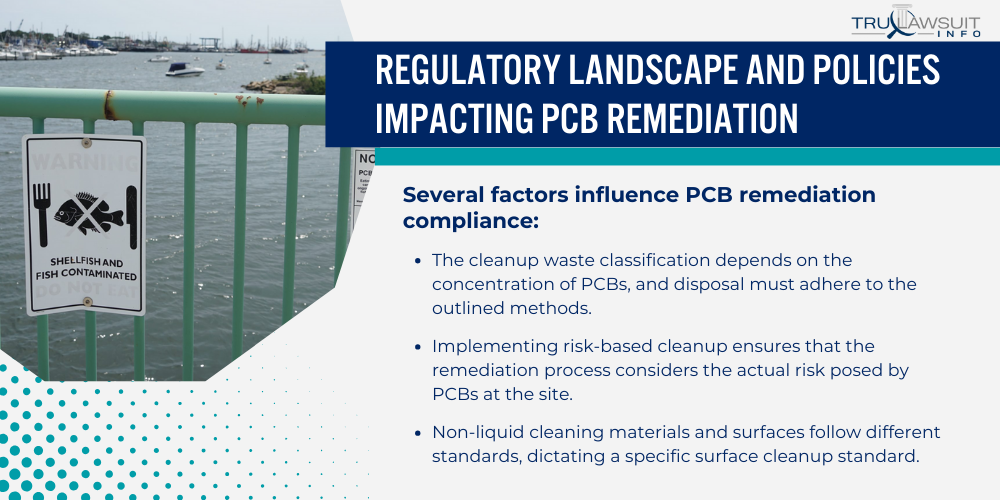
Key players in this field include government entities such as the EPA, which enforces regulations to ensure safe and effective cleanup operations.
Current PCB Remediation Standards and Compliance Issues
EPA approval is pivotal for the commencement of cleanup protocols.
Facilities engaged in PCB remediation must follow strict environmental guidelines to minimize human exposure to PCBs, deemed hazardous materials.
Regulations specify that each site must submit a cleanup completion notification to certify that the area meets the cleanup criteria.
Several factors influence PCB remediation compliance:
- The cleanup waste classification depends on the concentration of PCBs, and disposal must adhere to the outlined methods.
- Implementing risk-based cleanup ensures that the remediation process considers the actual risk posed by PCBs at the site.
- Non-liquid cleaning materials and surfaces follow different standards, dictating a specific surface cleanup standard.
- The PCB removal process, particularly from electrical equipment, includes numerous safety and contamination prevention measures.
The entity performing the cleanup, potentially a tribal environmental protection agency, has to follow sample collection procedures carefully to determine PCB levels accurately.
Funding & Resources for Implementing PCB Remediation Tech
Financing PCB remediation often involves tapping into resource conservation programs to support the costly endeavor of PCB extraction and disposal.
To ensure financial feasibility, remediation entities must be aware of any actual or proposed changes to these funding structures.
Several options can help secure resources for PCB remediation projects:
- Grants and loans can be obtained by entities that successfully meet the EPA’s criteria for such a permit.
- Technological advances in PCB extraction methods can affect the allocation and use of financial resources.
- Entities must regularly track unreasonable risk criteria to ensure ongoing compliance and eligibility for funding.
- Such disposal methods for PCB wastes often necessitate financial planning due to their impact on overall remediation costs.
Entities must seek EPA guidance on resource availability and apply for funding with detailed justification for the technology and methods used.
Challenges and Opportunities in PCB Remediation Innovation
Due to their toxic and persistent nature, polychlorinated biphenyl (PCB) remediation remains significant in environmental cleanup activities.
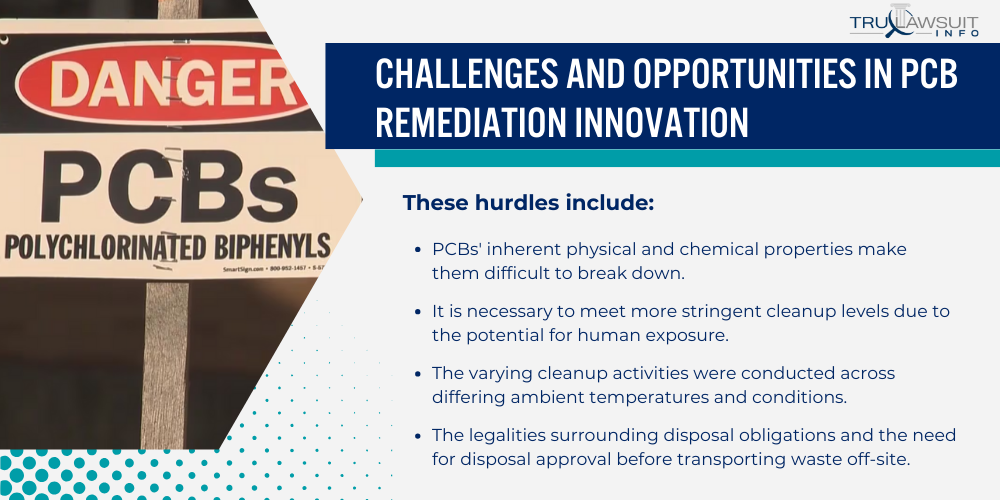
Innovation is key to surmounting obstacles and propelling the efficiency of PCB cleanup efforts.
Overcoming Obstacles to Adopting New PCB Remediation Tools
Effective remediation of PCB-contaminated sites is hampered by both physical and regulatory challenges.
These hurdles include:
- PCBs’ inherent physical and chemical properties make them difficult to break down.
- It is necessary to meet more stringent cleanup levels due to the potential for human exposure.
- The varying cleanup activities were conducted across differing ambient temperatures and conditions.
- The legalities surrounding disposal obligations and the need for disposal approval before transporting waste off-site.
To address these challenges, one can look for solutions combining innovation with practical applicability.
For instance, methods have been developed to stabilize contaminants in situ, reducing the chances of human exposure.
Similarly, advancements in cleanup technologies seek to meet the demand for remediation methods that can effectively dechlorinate PCBs, which typically involves removing chlorine atoms to reduce toxicity.
Collaborations Driving Progress in PCB Remediation R&D
Joint efforts between different sectors have accelerated research and development in PCB remediation.
Highlights of these collaborations include:
- Research partnerships forming between academic institutions and cleanup agencies to test emerging technologies.
- Integrating nanoscale materials like zero-valent iron to decontaminate soils and sediments in situ.
- Engage with stakeholders by implementing temporary emergency measures and creating immediate solutions for sudden contamination events.
- Continuous updates to regulatory frameworks that reflect the latest scientific advancements and promote safer, more efficient cleanup practices.
Working collaboratively enables sharing of knowledge and resources, which is essential when tackling the manifold challenges associated with PCB remediation.
Moreover, these efforts yield opportunities to improve existing techniques and innovate new ones that ensure the disposal of PCBs without adverse environmental impacts.
Planning Effective PCB Remediation Projects Step-by-Step
Effective PCB remediation projects require a detailed plan, which shapes the success of the cleanup from assessment to the finishing stages.
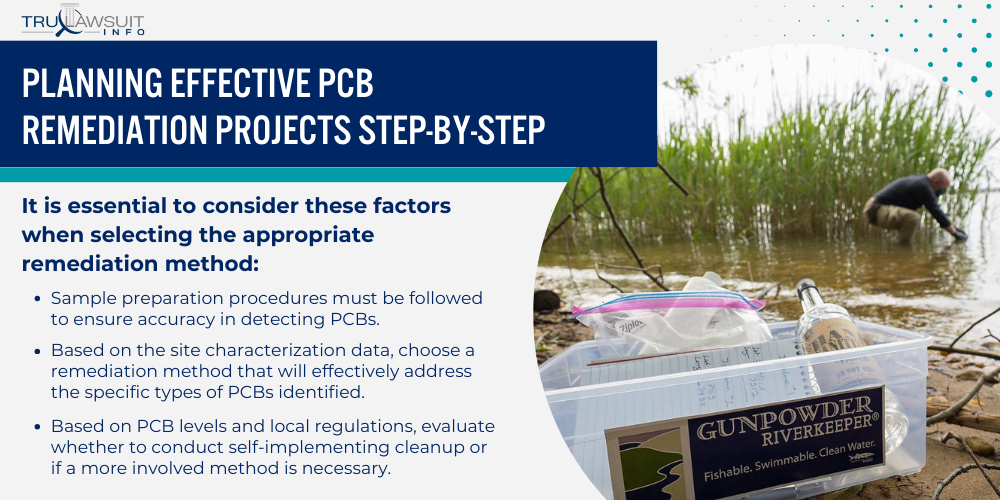
This section outlines a methodical approach to ensuring PCB removal is done safely and effectively.
Assessing Sites & Selecting Optimal PCB Remediation Methods
An initial step in planning is site characterization.
This process involves gathering pre-cleanup characterization samples to determine PCB contamination levels and specific locations.
It is essential to consider these factors when selecting the appropriate remediation method:
- Sample preparation procedures must be followed to ensure accuracy in detecting PCBs.
- Based on the site characterization data, choose a remediation method that will effectively address the specific types of PCBs identified.
- Based on PCB levels and local regulations, evaluate whether to conduct self-implementing cleanup or if a more involved method is necessary.
- Anticipate potential obstacles, such as access to areas of high contamination, and plan accordingly with safety and efficiency in mind.
Managing PCB Remediation Efforts for Cost-Effective Completion
A strategic approach to managing PCB remediation focuses on minimizing human exposure to harmful substances and optimizes resources for a cost-effective process.
Key management strategies to ensure a responsible and economical remediation project include:
- Developing a detailed project timeline to diligently track and manage the cleanup site progress.
- Employ budget tracking tools and conduct regular financial reviews to prevent cost overruns.
- Implement periodic health and safety audits to minimize human exposure and ensure adherence to safety protocols throughout the remediation.
- Engage in consistent communication with all involved parties, from on-site workers to stakeholders, to maintain transparency and alignment on project goals.
By following these structured steps and focusing on accuracy and efficiency, a PCB remediation project can be conducted effectively, safeguarding human health and the environment.
Frequently Asked Questions
-
What are the current standards for PCB cleanup?
The EPA regulates PCB cleanup standards under the Toxic Substances Control Act (TSCA).
Cleanup activities must adhere to specific concentration levels depending on the contaminated medium (e.g., soil, water).
These standards aim to reduce aqueous equilibrium PCB concentrations to safe levels for human health and the environment.
-
How can PCBs be effectively removed from water systems?
Activated carbon filtration, chemical decomposition reagents, and high-efficiency particulate air (HEPA) filters are commonly employed to effectively remove PCBs from water systems.
These methods are designed to reduce the PCB levels in water to meet the safety standards set by regulatory agencies.
-
What are the most effective methods for reducing PCB presence in the environment?
The most effective methods for reducing PCB presence in the environment include on-site thermal treatment, chemical dechlorination, and bioremediation techniques that break down PCBs into less harmful components.
Strategies are selected based on the site’s characteristics and PCB concentration levels.
Guidance for PCB regulations and cleanup can be sought from the US EPA Policy and Guidance documents.
-
What is considered bulk PCB remediation waste?
Bulk PCB remediation waste includes caulk, paint, or other non-liquid substances that originally contained PCBs in 50 ppm or higher concentrations.
It is handled by methods such as landfilling, chemical waste disposal, or incineration, all of which are regulated under TSCA.
The EPA document provides a comprehensive overview of waste containing PCBs.
-
What processes are involved in PCB treatment?
PCB treatment involves several processes, such as physical separation, thermal desorption, chemical dehalogenation, and biological treatments.
These processes aim to destroy or permanently alter PCBs to minimize toxicity and prevent further environmental contamination.
-
In what ways can PCB-contaminated sites be remediated?
PCB-contaminated sites can be remediated through excavation, on-site treatment, and the safe transport and disposal of contaminated materials per federal regulations.
The selected technique varies based on several factors, such as the extent of contamination and the surrounding environment.
The Federal Register provides detailed descriptions of cleanup and disposal regulations.

Experienced Attorney & Legal SaaS CEO
With over 25 years of legal experience, Jessie is an Illinois lawyer, a CPA, and a mother of three. She spent the first decade of her career working as an international tax attorney at Deloitte.
In 2009, Jessie co-founded her own law firm with her husband – which has scaled to over 30 employees since its conception.
In 2016, Jessie founded TruLaw, which allows her to collaborate with attorneys and legal experts across the United States on a daily basis. This hypervaluable network of experts is what enables her to share reliable legal information with her readers!
Have A Case?
Here, at Tru Lawsuit Info, we’re committed to helping victims get the justice they deserve.
To do this, we actively work to connect them with attorneys who are experts in litigating cases similar to theirs.
Would you like our help?
Tru Lawsuit Info is a reliable source of information about issues that may affect your health and safety, such as faulty products, data breaches, and environmental hazards.
Our team of experienced writers collaborates with medical professionals, lawyers, and advocates to produce informative articles, guides, and other resources that raise awareness of these topics.
Our thorough research provides consumers with access to reliable information and updates on lawsuits happening around the country. We also can connect consumers with attorneys if they need assistance.
Camp Lejeune's water contamination issue spanned several decades starting in the 1950s. Exposure to these chemicals has been linked to various serious health issues, including cancer, organ diseases, and death.
Research is increasingly suggesting a link between the use of Tylenol during pregnancy and the development of neurodevelopmental disorders, such as autism and ADHD, in infants.
Legal action is being taken against manufacturers of Aqueous Film-Forming Foam (AFFF), a chemical used in fighting fires. The plaintiffs allege that exposure to the foam caused health issues such as cancer, organ damage, and birth and fertility issues.
Have A Case?
Here, at Tru Lawsuit Info, we’re committed to helping victims get the justice they deserve.
To do this, we actively work to connect them with attorneys who are experts in litigating cases similar to theirs.
Would you like our help?







